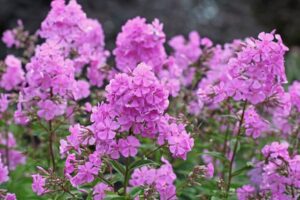
If you’re looking for a summer-blooming perennial that offers beauty, fragrance, and real benefits to pollinators, native garden phlox (Phlox paniculata) is a must-have. Its tall, colorful flower clusters brighten up borders and perennial gardens from midsummer into early fall. And while it’s certainly a stunning flower, it’s also doing a lot of work behind the scenes.
Phlox is especially valuable in our area, where hot, humid summers demand plants that can handle the conditions without giving in to disease. Fortunately, today’s improved Phlox varieties are not only more resistant to powdery mildew, but also more compact and better suited to modern garden spaces.
Some standout varieties include ‘Jeana’, ‘Glamour Girl’, and ‘Flame Pro Lilac’. Each brings something special to the garden. ‘Jeana’, named the 2024 Perennial Plant of the Year, is a true pollinator magnet. Its masses of small, lavender-pink flowers are not only beautiful, but were also found to attract more butterflies than any other phlox in trials at the Mt. Cuba Center. ‘Glamour Girl’ is a vibrant coral-pink variety with strong, upright stems and excellent resistance to powdery mildew. It offers a long bloom season, rich color, and is also great for cutting. ‘Flame Pro Lilac’ is more compact, with bold purple-lilac blooms and a tidy habit that makes it ideal for smaller gardens or containers.
One of the biggest reasons to grow garden Phlox is the sheer number of pollinators it supports. Butterflies, especially Eastern tiger swallowtails, skippers, and monarch, are drawn to its nectar-rich flowers, as are long-tongued bees and hummingbirds. Even when the flowers fade, the plants can offer structure and shelter to overwintering insects if left standing into the cooler months.
Garden Phlox is fairly easy to grow. It thrives in full sun and moist, well-drained soil, though it appreciates some afternoon shade in especially hot areas. Adding compost or organic matter at planting time will give it a strong start. Spacing plants to allow for good air circulation is key to avoiding mildew. Once established, Phlox appreciates regular watering during dry spells and will reward you with weeks of blooms. Deadheading can encourage even more flowering, and cutting plants back by about one-third after blooming may lead to a second flush of color later in the season.
Phlox also plays well with others in the garden. Since it typically blooms from mid to late summer, it pairs beautifully with other native perennials that hit their stride at the same time. Echinacea, Rudbeckia, and Monarda all bloom around the same time and attract many of the same beneficial insects.
For added texture and contrast, consider planting Liatris spicata, Coreopsis verticillata, or the silvery, pollinator-friendly blooms of Pycnanthemum muticum nearby. These combinations not only look great, but create a more diverse and supportive habitat for pollinators.
Phlox also earns a spot in the cutting garden. The strong stems and clustered blooms of varieties like ‘David’ and ‘Jeana’ hold up well in arrangements, and their fragrance adds a lovely touch indoors. Harvest stems when about one-third of the flowers are open for the longest vase life.
Whether you’re planting for pollinators, looking to refresh your summer garden, or simply want reliable color year after year, native garden Phlox is an excellent choice. With improved varieties that resist disease and thrive in our region, now’s the perfect time to add this classic perennial to your landscape.
